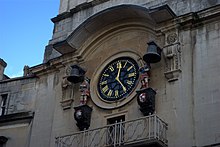James Paty the Elder
James Paty the Elder | |
|---|---|
| Died | 1748 |
| Nationality | British |
| Occupation | Architect |
James Paty the Elder (sometimes spelled Patty) (died 1748) was an English mason, builder and architect. He was the first in a succession of members of the Paty family prominent in the building of 18th century Bristol. He is thought to have been the architect of Bristol's Old Library on King Street.[1][2]
Paty family
There is no definite evidence for the relation of James to the other members of the Paty family. He was not the father, but probably the uncle or some other relation of
Works


James Paty the Elder carved the wooden
Some other buildings are attributed to him, though not with certainty, as builder or architect: houses on Unity Street and College Green,[9] and the Old Library on King Street. For the library he is known to have been at least the mason and stone carver, and is thought to have been the architect too. Unfortunately, most of the library's ornamentation has been lost over time and as a result of repairs: in particular, a fine Bristol coat of arms on the pediment and figures of putti depicted reading books above the first floor windows.[8][10][11]
List of works
- Christ Church (1728) (as carver)[7]
- 30 College Green (possibly) (c. 1730)[12]
- Old Library (1738–40) (probably architect)[13]
- The Exchange (1741–43) (as carver)[4]
- 1 and 3–9 Unity Street (possibly) (c. 1742)[14]
References
- ISBN 0-300-10442-1.
- ISBN 1-900178-54-0.
- ISBN 1-900178-54-0.
- ^ ISBN 1-900178-54-0.
- ISBN 0-85331-409-8.
- ^ ISBN 1-900178-54-0.
- ^ a b "Christ Church with St Ewen". historicengland.org.uk. Retrieved 30 August 2007.
- ^ ISBN 1-900178-54-0.
- ISBN 0-85331-409-8.
- ISBN 0-85331-409-8.
- ISBN 1-872971-26-1.
- ^ "30 College Green". historicengland.org.uk. Retrieved 30 August 2010.
- ^ "The Old Library and attached front area, wall pier and railings, 30 King Street". historicengland.org.uk. Retrieved 30 August 2010.
- ^ "1 and 3–9 Unity Street". historicengland.org.uk. Retrieved 30 August 2010.
